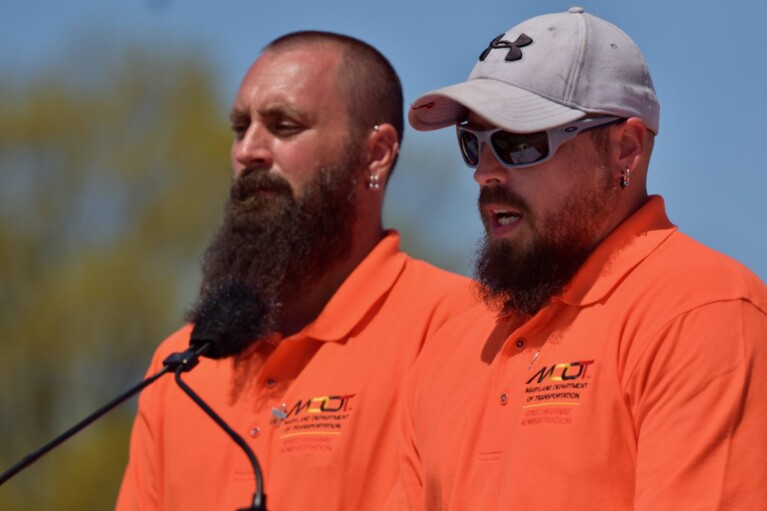Opinion: Modified or not, toll lane plan will cement inequity and worsen traffic for most

By Brian Ditzler
The writer is a member of Maryland Advocates for Sustainable Transportation, a coalition of advocate groups concerned about former Gov. Larry Hogan’s plan to expand I-495 and I-270. MAST supports policies that address the climate crisis and transportation problems.
The public has been waiting for Gov. Wes Moore (D) to end the Hogan administration’s ill-conceived toll lane plan and choose better alternatives for the I-495/I-270 corridor. The project’s original private partner, Australian toll giant Transurban, has walked away. A Washington Post poll shows majorities in Montgomery and Prince George’s Counties oppose the toll lanes. The inherent inequity of the project conflicts with Governor Moore’s stated values.
Yet, the toll lane plan is still on the table. The Maryland Department of Transportation may be considering a new private partner, state funding, downsizing, or other modifications. But these changes won’t alter the project’s fundamental problems: the plan will remain intrinsically inequitable, leave the vast majority of drivers worse off and less safe, and disproportionately harm low and moderate wage earners.
Any form of the toll lane plan divides the wealthy from the rest. Regardless of how the project is financed or re-scoped, the regular lanes must remain congested enough to motivate wealthier drivers to — as the Washington Post put it — pay to “escape the usual crawl in the regular lanes.” The tolls have to be high enough to keep most drivers out of the toll lanes. Otherwise, the toll lanes would fill up and slow down and no one would pay to use them. As explained on the Federal Highway Administration website: “Revenue potential and overall financial success [of managed toll lanes] depends on the operational failure of adjacent general purpose lanes.”
Any form of the plan decreases safety for the majority. The project’s policies and design prioritize the safety of toll lane users vs. all highway users. Although MDOT’s public-facing documents don’t call this out, internal documentation makes it clear. The Maryland Transit Authority, for instance, says the purpose of annual toll rate escalations is to provide “customers who choose to pay a toll a safer, faster and more reliable driving experience.” The project’s original partner, Transurban, touts toll lane safety in its marketing materials. “Get where you need to go faster and safer on our Lanes…” The same features that make the toll lanes safer make the regular lanes more dangerous.
- The inside shoulder is taken from the regular lanes and given to the toll lanes.
- Eighteen-wheelers, priced out of the toll lanes, are crammed into the regular lanes.
- The resulting crowding and congestion, poorer emergency response access, and maneuvering at new entrances and exits consign regular-lane drivers to a more dangerous drive.
- Northern Virginia’s toll lanes employ similar designs and policies. The result, according to the Virginia Department of Transportation, has been a significantly higher crash rate along certain stretches of I-495.
Any form of the plan simply pushes Northern Virginia’s bottleneck into Maryland. Where toll lanes end, the existing bottlenecks get worse and/or new bottlenecks form. MDOT’s plan will create a new bottleneck at Old Georgetown Road on the eastern I-270 spur and exacerbate the notorious northern bottleneck on I-270 in Gaithersburg, one of the most diverse cities in the U.S.
Any form of the plan disproportionally hurts low and moderate wage earners. Essential workers who can’t work from home and can’t afford daily tolls are hardest hit by the toll lane plan. These workers put their lives on the line during the worst years of the pandemic. The toll lane plan would leave them with worse congestion and less safe conditions than they experience now. They and the majority of Marylanders would see their tax dollars go to subsidize toll lanes they can’t afford to use.
Any form of the plan causes grave harm to nearby neighborhoods, with little or no public benefit. At most exits, the toll lane design forces drivers to leave the highway and use local roads to switch between tolled and regular lanes. In Rockville, for instance, that means unwanted construction to replace existing bridges and build additional ones to accommodate the toll lanes. It means increased traffic and pollution and decreased safety on busy neighborhood streets. Costs for local mitigation will be borne by taxpayers.
To move Maryland forward while leaving no one behind, we urge the Moore administration to turn to smart, effective alternatives that can be initiated now:
- Begin serious study of the upper I-270 corridor, an area in urgent need of congestion relief measures that is not addressed in the current toll lane plan. The public can give robust input on highway and transit alternatives.
- Support the WMATA Better Bus Visionary Network redesign, with its excellent frequency-of-service feature.
- Address existing chokepoints along I-495 by applying spot improvements and some of the innovative congestion management techniques that have dramatically reduced congestion on lower I-270.
- Incentivize transit use and employ policies to stagger work-from-home days to even out weekly traffic and transit flows.
- Solicit federal funds to redeck and refurbish the American Legion Bridge.
Major long term strategies to pursue include expanding the MARC Brunswick line; creating dedicated bus lanes through the corridor and new bus rapid transit lines; expeditiously finishing the Purple Line; using state transportation and infrastructure funds to support mixed-income, transit-oriented development near Metrorail, Purple Line, and MARC stations; and continually monitoring the effectiveness of efforts to improve transportation in the I-495/I-270 corridor.
It’s time to close the book on former Gov. Larry Hogan’s unfixable toll lane plan. Governor Moore has the opportunity to create a legacy of equitable, safe, effective transportation that serves the needs of everyone in our region.




 Creative Commons Attribution
Creative Commons Attribution